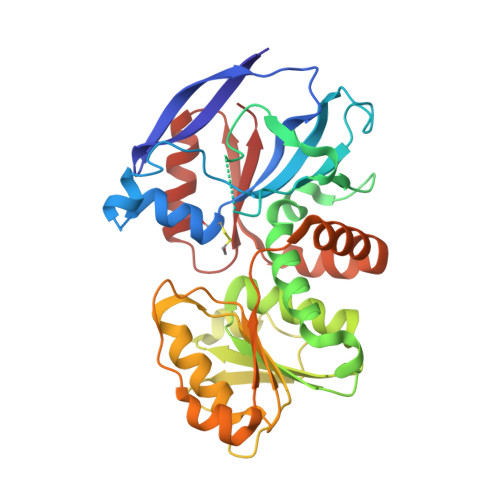Crystallographic analysis of TarI and TarJ, a cytidylyltransferase and reductase pair for CDP-ribitol synthesis in Staphylococcus aureus wall teichoic acid biogenesis.
Li, F.K.K., Gale, R.T., Petrotchenko, E.V., Borchers, C.H., Brown, E.D., Strynadka, N.C.J.(2021) J Struct Biol 213: 107733-107733
- PubMed: 33819634
- DOI: https://doi.org/10.1016/j.jsb.2021.107733
- Primary Citation of Related Structures:
6XH9, 6XHK, 6XHP, 6XHQ, 6XHR, 6XHS, 6XHT - PubMed Abstract:
The cell wall of many pathogenic Gram-positive bacteria contains ribitol-phosphate wall teichoic acid (WTA), a polymer that is linked to virulence and regulation of essential physiological processes including cell division. CDP-ribitol, the activated precursor for ribitol-phosphate polymerization, is synthesized by a cytidylyltransferase and reductase pair known as TarI and TarJ, respectively. In this study, we present crystal structures of Staphylococcus aureus TarI and TarJ in their apo forms and in complex with substrates and products. The TarI structures illustrate the mechanism of CDP-ribitol synthesis from CTP and ribitol-phosphate and reveal structural changes required for substrate binding and catalysis. Insights into the upstream step of ribulose-phosphate reduction to ribitol-phosphate is provided by the structures of TarJ. Furthermore, we propose a general topology of the enzymes in a heterotetrameric form built using restraints from crosslinking mass spectrometry analysis. Together, our data present molecular details of CDP-ribitol production that may aid in the design of inhibitors against WTA biosynthesis.
- Department of Biochemistry and Molecular Biology and Centre for Blood Research, The University of British Columbia, Vancouver, British Columbia V6T 1Z3, Canada.
Organizational Affiliation:


















